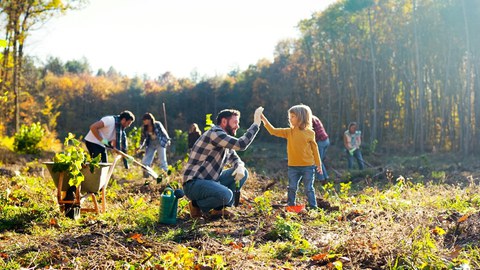Jun 02, 2023
Interactive Research – Reforestation: What Does Your Future Forest Look Like?
Two Chairs at TU Dresden have started the DIA-WALD joint project, which seeks to strengthen social dialog about reforestation measures – and they are looking for your help.
The appearance of the forest has changed drastically in many places over the past several years. Visitors are often shocked by what they find. Where once many large, towering trees stood surrounded by lush greenery, there are now just the dead, bare remnants, rendering some forests brown and gray. Reports show a sharp decline in vitality across all species of trees, though spruces have been hit the hardest. The causes are manifold and complex, and they include drought, insect damage, forest fires and storms.
However, things will not stay this way. In most of these areas – whether this change is steered by humans or left to nature to sort out – a new forest will grow and develop. Where humans intervene and purposefully sow or plant new trees, there are great opportunities for people who are interested in and committed to the cause to get involved. You, too, can help grow the forest of the future.
First hands-on campaign launched
The research conducted within the DIA-WALD project draws on this idea. Future forest images illustrate how people imagine the new forest being grown on the many bare areas should look. Their ideas about the ideal forest of the future offer a constructive basis for research. These conceptualizations and forest images can then be used to determine what properties and functions of the forest are viewed as essential. Based on these findings, a list of substantial criteria will be drafted over the course of the project that a future forest must fulfill in the eyes of society.
DIA-WALD therefore invites people to take photos of patches of forest that correspond with their idea of a future forest and to digitally fill in any gaps. Completely digital images of a forest of the future may also be created or drawn.
The photo or digital image can be uploaded to the DIA-WALD project website: https://tu-dresden.de/bu/umwelt/forst/dia-wald/projekt/news/zukunftswald-gesucht-2
Further information about the hands-on campaign and the DIA-WALD project can be found (in German) here: https://tu-dresden.de/bu/umwelt/forst/dia-wald/
About the project
DIA-WALD is a project funded by the Fachagentur Nachwachsende Rohstoffe (Expert Agency for Renewable Resources, FNR), bringing together silvicultural decision-making and public involvement. The team comprising staff from the Chair of Forest Policy and Forest Resource Economics and the Chair of Silviculture at TU Dresden is investigating both the silvicultural requirements for the successful reforestation of blemished areas as well as society’s expectations for the forest of the future. The goal is to compile communication strategies that suit the target groups and media with a view to promoting acceptance of forestry measures within the scope of sustainable forest management and reforestation.
Two subsections of the research project
The silvicultural section of the project investigates blemished areas in the forest with regard to the diversity of their functions and special ecosystem performance. As a result, the researchers are able to establish important silvicultural parameters (e.g. surface area, location conditions, cause and degree of the disturbance, composition of tree species). These parameters should serve as a foundation for a decision about how to move forward with damaged forest areas and thus facilitate the selection of a suitable plan of action.
Beyond investigating the previous social dialog and communication structure surrounding reforestation measures of forestry experts, the forest policy section of the research project also seeks to expand and optimize future communication and societal participation in this area. To this end, the project will begin by analyzing knowledge about forest damage, the perception of damaged forest areas and expectations with regard to blemished areas in the forest in society and amongst forestry experts. Other sociological questions address which media share information about blemished forest areas and their reforestation, what information this is, and the extent to which those interested in forests actively seek information on the topic of reforestation. Based on the results, the goal is to develop information and communication strategies that suit the target groups and media in order to enhance the dialog about sustainable forest development. Everyone who is committed to the preservation of healthy, sustainable forests stand to benefit from these efforts. The DIA-WALD project is set to run until November 2025.
Contacts:
Sandra Liebal & Josephine Köhler
Tel.: +49 351 463-31848
Tel.: +49 351 463-31858

